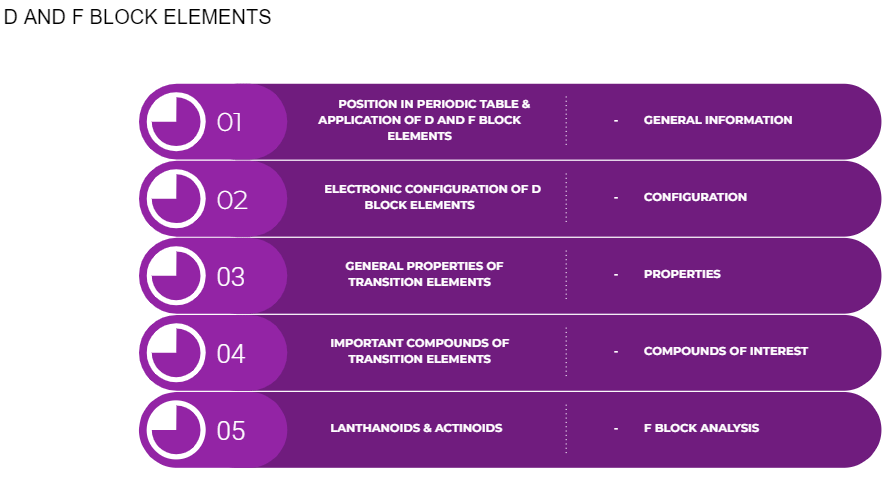NEET Exam > NEET Notes > Inorganic Chemistry for NEET > Index: d & f-Block Elements
Index: d & f-Block Elements | Inorganic Chemistry for NEET PDF Download

1. General intro
- Video: General Properties of Transition Elements
- Doc: Manganate and Permanganate
- Doc: General Properties of Transition Elements: The d- and f- Block Elements
- Test: General Chemical & Magnetic Properties Of d- And f-Block Elements
2. General properties of d block elements
- Video: Electronic Configuration of the d-Block Elements
- Video: Variable Oxidation States of Transition Elements
- Video: Variation in Atomic and Ionic Sizes of Transition Metals
- Video: Trends in Ionization Enthalpy of Transition Elements
- Video: Trends in Physical Properties of Transition Elements
- Video: Trends in Stability of Higher Oxidation States of Transition Elements
- Video: Trends in Standard Electrode Potential of D Block Elements
- Video: Chemical Reactivity of Transition Elements
- Video: Catalytic Properties of Transition Metals
- Video: Formation of Complex Compounds and Catalytic Properties
- Video: Formation of Interstitial Compounds and Alloy Formation
- Video: Important Compounds of Transition Elements
- Video: Magnetic Properties of Transition Metals:(part - 1)
- Video: Magnetic Properties of Transition Metals (part - 2)
- Test: Introduction To d-Block Elements
- Test: General Properties Of d-Block Elements
- Test: Important Compounds Of d-Block
3. Coloured ions
- Video: Formation of Coloured Ions
4. F-block elements
5. Oxides and oxoanions of elements
6. Lanthanoids and Actinoids
- Video: What are Lanthanoids
- Video: The Lanthanides
- Video: Lanthanoid Contraction
- Video: What are Actinoids
- Video: The Actinoids
- Video: Comparison of lanthanoids and Actinoids
- Test: f-Block Elements (Lanthanides)- I
- Test: f-Block Elements (Actinides)- II
- Test: Lanthanoids And Actinoids
- Doc: Lanthanides and Actinides
7. NCERT material
- Doc: NCERT Textbook: d- and f-Block Elements
- Doc: NCERT Solutions: d- and f-Block Elements
- Doc: NCERT Exemplar - D and F - Block Elements
8. NEET questions
- Test: 28 Year NEET Questions: The D And F-Block Elements- 1
- Test: 28 Year NEET Questions: The D And F-Block Elements- 2
- Doc: NEET Previous Year Questions (2014-21): The d and f-Block Elements
9. Chapter tests and other docs
- Test: d & F Block Elements- 1
- Test: d & F Block Elements- 2
- Test: Previous Year Questions: d- and f-Block Elements
- Test: D and F - Block Elements- Assertion & Reason Type Questions
- Test: D and F - Block Elements- Case Based Type Questions
- Test: General Chemical & Magnetic Properties of D And F Block
- Test: Previous Year Questions - D & F Block (Level 1)
- Test: Level - 2 D & F Block - 1
- Test: The D And F-Block Elements 1 - From Past 28 Years Questions
- Test: The D And F-Block Elements 2 - From Past 28 Years Questions
- Doc: MCQs Question Bank Solutions (Competition Preparation): d- and f-Block Elements
- Doc: MCQs Question Bank (Competition Preparation): d- and f-Block Elements
- Doc: Short & Long Answer Question: The d- and f-Block Elements- 1
- Doc: Short & Long Answer Question(Part-2) - The d & f block elements
- Doc: Important Formulas & Rapid Revision: D and F - Block Elements
The document Index: d & f-Block Elements | Inorganic Chemistry for NEET is a part of the NEET Course Inorganic Chemistry for NEET.
All you need of NEET at this link: NEET
|
80 videos|112 docs|110 tests
|
FAQs on Index: d & f-Block Elements - Inorganic Chemistry for NEET
| 1. What are d-block elements? |  |
Ans. D-block elements, also known as transition elements, are a group of elements in the periodic table that have partially filled d orbitals in their atomic state. They are located in the middle of the periodic table between the s-block and p-block elements.
| 2. How are f-block elements different from d-block elements? |  |
Ans. F-block elements are also known as inner transition elements and are located at the bottom of the periodic table. They have partially filled f orbitals in their atomic state, which differentiates them from d-block elements. F-block elements are further divided into lanthanides and actinides.
| 3. What are the properties and characteristics of d-block elements? |  |
Ans. D-block elements possess several unique properties and characteristics. They exhibit variable oxidation states due to the availability of different d orbitals for bonding. They are good conductors of heat and electricity and show high densities and melting points. D-block elements also form colored compounds and can act as catalysts.
| 4. How do d-block elements contribute to the biological processes in living organisms? |  |
Ans. D-block elements play crucial roles in various biological processes in living organisms. For example, iron (Fe) is an essential element for the formation of hemoglobin in red blood cells, which transports oxygen throughout the body. Copper (Cu) is involved in enzyme activity, while zinc (Zn) is required for proper functioning of enzymes and DNA synthesis.
| 5. How are d-block elements used in everyday life and industries? |  |
Ans. D-block elements find numerous applications in everyday life and industries. For instance, transition metals like iron (Fe) and chromium (Cr) are used in the manufacturing of stainless steel, which is widely used in kitchen appliances and construction. Transition metals also serve as catalysts in various industrial processes, such as the Haber process for ammonia synthesis.
Related Searches





















